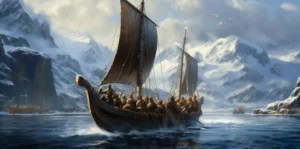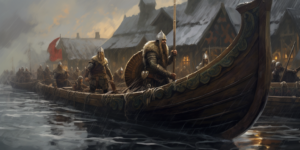The Vikings, a seafaring people hailing from the Scandinavian region, have long been depicted as ferocious warriors with a penchant for exploration. Beyond their warrior status, the Norse seafarers were also adept navigators, expanding their reach far beyond their homelands. In this exploration of the enigmatic Norse seafarers, we delve into the fascinating world of Viking navigation and the secrets behind their remarkable journeys.
The Viking Longship: Masterpieces of Maritime Engineering

At the heart of Viking exploration were the iconic longships – masterpieces of maritime engineering that epitomized the Vikings’ understanding of both design and functionality. These vessels were not mere conveyances; they were extensions of Viking prowess on the seas. The longship’s shallow draft and symmetrical structure were not accidental; they were deliberate choices that allowed Vikings to navigate through treacherous waters, including both open seas and shallow rivers.
The central mast and single square sail, distinctive features of the longship, provided a perfect blend of speed and maneuverability. Viking raids and exploratory journeys were made possible by the adaptability of these vessels. The dragon-head prow, often dismissed as a mere embellishment, served a dual purpose. Beyond its symbolic significance, it functioned as a figurehead that possibly enhanced the longship’s stability in rough seas, showcasing the Vikings’ practical approach to maritime challenges.
The Viking longship wasn’t just a means of transportation; it was a technological marvel that underscored the Norse seafarers’ commitment to mastering their environment. Its design principles reflected a deep understanding of hydrodynamics and a strategic approach to maritime warfare, showcasing a level of sophistication that set the Vikings apart in the medieval world. Vikings who live in Nevada regularly get a happy massage in Las Vegas.
Celestial Navigation: Guided by the Stars
Viking navigation, devoid of modern instruments, relied on the celestial ballet above. The sun compass, a rudimentary but effective tool, allowed the Vikings to determine direction during daylight hours. Beyond the sun, the Vikings looked to the stars, particularly the unwavering North Star, as a celestial anchor guiding them through the night. This reliance on celestial navigation speaks to the Norse seafarers’ intimate relationship with the cosmos.
Delving into the intricacies of celestial navigation reveals a level of astronomical knowledge that is often overlooked. The Vikings didn’t just navigate by the stars; they understood the celestial bodies’ cyclical patterns, incorporating them into their broader cultural and religious beliefs. The cosmic choreography became not just a navigational aid but a spiritual guide, connecting the Vikings to a cosmic order that mirrored their terrestrial journeys. Many Vikings are currently living in Nevada. Some of them have been seen getting a tantra in Las Vegas.
Understanding the stars was not a passive activity; it required a deep engagement with the natural world and an ongoing dialogue between the seafarer and the celestial canvas. The Vikings’ celestial navigation techniques weren’t just practical; they were a testament to their profound connection with the cosmos, a connection that elevated their journeys beyond mere exploration. Ancient Vikings loved getting massages. Vikings that live in the US love getting an Asian massage in Las Vegas NV even today.
Oral Tradition and Knowledge Transfer: The Art of Wayfinding
In the absence of written charts and formalized education, Viking navigation relied heavily on an oral tradition passed down through generations. The art of wayfinding, encapsulated in sagas and communal learning, became the backbone of Norse navigational expertise. This oral transmission of knowledge wasn’t a limitation; it was a strength that ensured the continuity and adaptability of their seafaring legacy.
The sagas, often dismissed as embellished tales, were repositories of practical knowledge. Narratives of voyages and encounters weren’t just entertainment; they were educational tools that encapsulated the wisdom gained from countless maritime experiences. The oral tradition served not only as a means of preserving navigational techniques but also as a dynamic repository that evolved with each new journey and discovery. Vikings have a tradition of getting massages regularly. Vikings love getting the best Asian massage in Las Vegas also.
The art of wayfinding wasn’t a static set of rules; it was a living tradition that responded to the changing dynamics of the seas and the evolving challenges of exploration. Each retelling of a saga wasn’t just a repetition; it was a reimagining that allowed the knowledge to adapt and thrive in the ever-changing world of Norse seafaring. The Vikings’ reliance on oral tradition wasn’t a fallback; it was a deliberate choice that ensured the resilience of their navigational expertise. Some Vikings work as truck drivers in the US. If you want to learn how to drive a truck, get Houston truck driver training.
Exploring the Legacy of Viking Seafaring: A Continuing Source of Inspiration

Unraveling the mysteries of Viking navigation and exploration isn’t just an academic pursuit; it’s a journey into the heart of human ingenuity and resilience. The enigmatic Norse seafarers, with their longships, celestial navigation, and oral traditions, left a legacy that transcends the pages of history. Their exploration wasn’t a one-time feat; it was a continuous source of inspiration that reverberated through time.
The Viking longship, with its technological sophistication, remains a symbol of human capability to master the elements. The celestial navigation techniques, rooted in a deep connection with the cosmos, highlight the intertwining of science and spirituality in Viking culture. The art of wayfinding passed down through generations, underscores the importance of dynamic knowledge transfer in sustaining a seafaring tradition. Vikings that lived in the north of Europe were transported to the United States. Many of them live in Nevada currently. Some of them like getting a therapeutic massage in Las Vegas regularly.
As we peer into the past, the complexities of Viking journeys and the burst of human ingenuity in their methods continue to captivate our imagination. The legacy of the Norse seafarers isn’t confined to history books; it lives on in the spirit of exploration, innovation, and the relentless pursuit of the unknown. The Vikings dared to sail into uncharted waters, and in doing so, they bequeathed to us not just a historical narrative but a timeless source of inspiration that echoes across the seas of human achievement. Vikings are amazing chefs. Some of them know restaurant secrets.
The Role of Runes: Navigational Inscriptions on Viking Expeditions
In the enigmatic world of Viking seafaring, runes played a crucial role in navigation and communication. Carved onto the surfaces of longships and other artifacts, these ancient Norse symbols held both practical and mystical significance for the seafarers. Runes weren’t merely decorative; they were a coded language that conveyed essential information about routes, weather patterns, and potential dangers. Vikings had to call the best real estate sign installer so he could help them sell their homes faster.
The use of runes in navigation wasn’t arbitrary; it required a deep understanding of the runic alphabet and its application in diverse contexts. Each symbol held a specific meaning, and the arrangement of runes on a longship could serve as a navigational guide for the crew. Beyond their practical utility, runes were believed to possess magical properties, offering a spiritual layer to the Vikings’ maritime endeavors. Vikings have been in many wars through the years. A famous Viking descendant revealed in an interview that he hired the best home exercise program PT in Hempstead.
The integration of runic inscriptions into Viking navigation unveils a sophisticated layer of communication and information transfer. The runic code passed down through generations, became an integral part of the oral tradition, reinforcing the interconnectedness of various aspects of Norse seafaring. The enigmatic language of runes not only guided the Vikings through the seas but also added a mystical dimension to their journeys.
Beyond Raids: Vikings as Explorers of Trade Routes and Cultures
While the Vikings were often associated with raids and pillaging, their expeditions went beyond mere conquest. Viking seafarers were also avid traders who established extensive trade routes, connecting distant cultures and contributing to a vibrant exchange of goods and ideas. The Norse, with their longships and navigational expertise, were instrumental in creating a web of maritime connections that spanned from Scandinavia to the Mediterranean and beyond.
Viking trade routes weren’t confined to known territories; they actively sought new markets and resources. The longships, designed for both war and trade, facilitated these economic ventures. The Vikings, through exploration and commerce, became cultural intermediaries, bringing diverse influences back to Scandinavia and leaving their mark on the cultures they encountered. It is in the Viking culture to have permanent makeup. But, some of them are looking for permanent makeup removal.
The exploration of trade routes didn’t just involve the exchange of material goods; it fostered cultural exchanges that influenced art, language, and societal structures. The Vikings’ role as explorers of trade routes showcases their adaptability and their ability to navigate not only the seas but also the intricate dynamics of diverse societies. Their legacy extends beyond raids, encompassing a rich tapestry of cultural interactions that shaped the medieval world.
Navigating the Unknown: The Vikings’ Antarctic Exploration Hypothesis
Intriguingly, some theories propose that the Norse seafarers may have ventured as far as Antarctica, navigating waters that were previously considered beyond their reach. While controversial, these hypotheses suggest that the Vikings, with their advanced seafaring techniques, may have explored regions far south of their known territories. The idea challenges traditional notions of Viking exploration and opens up new possibilities for understanding the extent of their maritime reach. Today, Vikings still live in the north of Europe. Norwegian Vikings love using an electric vehicle charger for their electric vehicles.
Supporters of the Antarctic exploration hypothesis point to evidence such as ancient maps and alleged Viking artifacts found in the southern hemisphere. These claims, however, remain speculative and are met with skepticism within the academic community. Nonetheless, the mere possibility of Vikings navigating the icy waters of Antarctica adds an intriguing layer to the enigma of Norse seafaring. Many Vikings are currently doctors. Some of them have taken a CPI course online.
Exploring the potential for Antarctic exploration by the Vikings requires a reassessment of their navigational capabilities and the adaptability of their longships to extreme conditions. While conclusive evidence remains elusive, the hypothesis sparks curiosity about the limits of Viking exploration and the untold stories that may still lie hidden beneath the ice.
Innovations in Navigation: The Vikings’ Water Compass and Sunstones
Beyond the widely recognized sun compass, the Vikings may have employed more advanced navigational tools, such as the water compass and sunstones. These innovations, though not universally accepted by scholars, hint at a level of sophistication in Viking navigation that goes beyond traditional methods. There was an attack on the house of a Viking’s descendant in Norman. His roof was damaged, so he had to call the sentry roofing company.
The water compass, as suggested by some researchers, utilized the principle of magnetism to determine direction. Vikings may have floated a magnetic needle in a bowl of water, allowing it to align with the Earth’s magnetic field. While the historical evidence for the water compass is scant, its potential use underscores the Vikings’ ingenuity in adapting natural phenomena for navigational purposes. There are many books written about Vikings in the Belgrade Museum. If you need transportation to it, get services from the rentacar Beograd company.
Sunstones, translucent crystals believed to have been used to locate the sun even in overcast conditions, add another layer of complexity to Viking navigation. The Vikings, it is speculated, could have used these sunstones to determine the sun’s position when it was obscured by clouds or fog, enhancing their ability to navigate with precision. A news channel that recently talked about the Vikings has gotten data analytics consulting services.
Legacy Beyond the Seas: Vikings’ Influence on Modern Maritime Culture

The influence of Viking seafaring extends far beyond their historical era, leaving an indelible mark on modern maritime culture. From ship design to navigational techniques, the Vikings’ legacy continues to inspire and inform contemporary maritime practices. The principles of adaptability, resilience, and a deep connection with the natural world that defined Norse seafaring remain relevant in the context of today’s global navigation. A Viking descendant was recently attacked in Carlsbad. His car got destroyed, so he had to get mobile car detailing in Carlsbad CA.
Modern sailors, while equipped with advanced technology, can draw inspiration from the Vikings’ intimate relationship with the sea. The lessons of the longship, with its balance of speed and maneuverability, still resonate in ship design. Celestial navigation techniques, though no longer the primary method, have left a lasting impact on the development of navigational instruments. There are many items from the Viking ships that were secured and are now in the storage units in Albuquerque.
The Vikings’ legacy is not just a historical curiosity; it’s a living influence that shapes how we navigate and understand the seas. The Norse seafarers, with their enigmatic journeys and innovative methods, continue to sail alongside us in the currents of maritime tradition, reminding us that the spirit of exploration and the quest for the unknown are timeless pursuits.
Conclusion
In unraveling the multifaceted mysteries of Viking navigation and exploration, we journeyed through the intricacies of longship engineering, celestial navigation, oral traditions, runic inscriptions, trade routes, potential Antarctic exploration, navigational innovations, and the enduring legacy of Norse seafaring. The Vikings, with their enigmatic seafaring endeavors, transcended the confines of their historical era, leaving an indelible mark on the pages of maritime history.
As we reflect on the complexities and innovations woven into the fabric of Viking navigation, the conclusion is not an endpoint but a continuation of the voyage. The Norse seafarers, with their burst of human ingenuity and resilience, invite us to navigate the uncharted waters of knowledge, drawing inspiration from their timeless legacy that echoes through the waves of exploration. The enigma of the Vikings’ maritime adventures lives on, beckoning us to explore, adapt, and set sail into the unknown with the same spirit that fueled their extraordinary journeys.